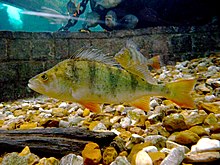European perch
| European perch | |
|---|---|
 |
|
 |
|
| Scientific classification | |
| Kingdom: | Animalia |
| Phylum: | Chordata |
| Class: | Actinopterygii |
| Order: | Perciformes |
| Family: | Percidae |
| Genus: | Perca |
| Species: | P. fluviatilis |
| Binomial name | |
|
Perca fluviatilis Linnaeus, 1758 |
|
 |
|
| Red = native range Green = introduced range |
|
Perca fluviatilis, commonly known as the European perch, perch, redfin perch, big-scaled redfin, English perch, Eurasian perch, Eurasian river perch or common perch, is a predatory species of perch found in Europe and northern Asia. The species is a popular quarry for anglers, and has been widely introduced beyond its native area, into Australia, New Zealand, and South Africa. They have caused substantial damage to native fish populations in Australia and have been proclaimed a noxious species in New South Wales.
European perch are greenish with red pelvic, anal and caudal fins. They have five to eight dark vertical bars on their sides. When the perch grow larger, a hump grows between its head and dorsal fin.
European perch can vary greatly in size between bodies of water. They can live for up to 22 years, and older perch are often much larger than average; the maximum recorded length is 60 cm (24 in). The British record is 2.8 kg (6 lb 2 oz), but they grow larger in mainland Europe than in Britain. As of May 2016, the official all tackle world record recognised by the International Game Fish Association stands at 2.9 kg (6 lb 6 oz) for a Finnish fish caught September 4, 2010. In January 2010 a perch with a weight of 3.75 kg (8 lb 4 oz) has been caught in the River Meuse, Netherlands. Due to the low salinity levels of the Baltic Sea, especially around the Finnish archipelago and Bothnian Sea, many freshwater fish live and thrive there. Perch especially are in abundance and grow to a considerable size due to the diet of Baltic herring.
The range of the European perch covers fresh water basins all over Europe, excluding the Iberian peninsula. Their range is known to reach the Kolyma River in Siberia to the east. It is also common in some of the brackish waters of the Baltic Sea.
...
Wikipedia

